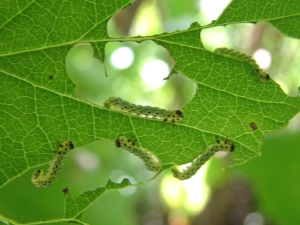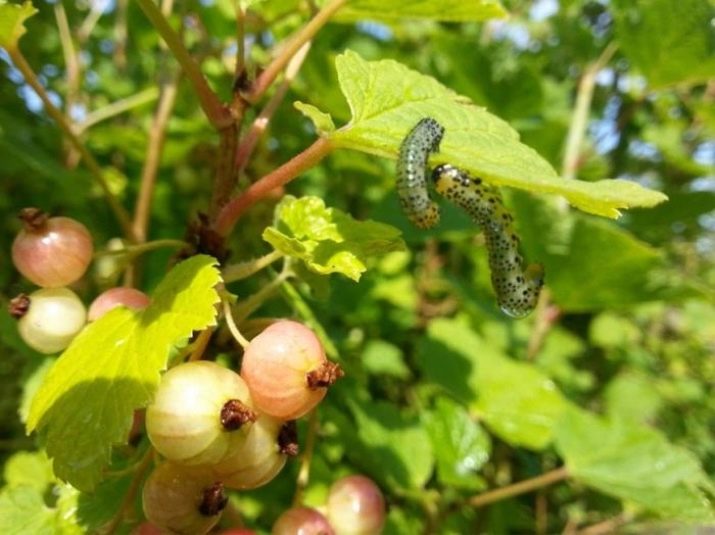How to deal with gooseberry sawflies?

With regard to such a pest as sawfly, various methods of control are acceptable, including folk recipes.But it is equally important to carry out preventive treatment of gooseberry bushes during the season.
What is it like?
Gardeners are well aware of the danger posed by the gooseberry sawfly, especially the second generation of this insect, when there are no leaves left on the crop, its growth and, therefore, fruiting are slowed down and stopped. The result is a yield loss.
The most dangerous variety of this harmful creature for the berry bush is the yellow sawfly, although the caterpillars of pale-footed individuals, which appeared first on the red currant, later develop on the gooseberry and inflict on it no less significant damage. Externally, the yellow pest has a yellow-red color, while its pale-legged appearance can be identified by its black color with pale spots. Caterpillars are green or blue, they are able to hibernate, hiding in the root zone of the plant.
The attack on the gooseberry begins in spring with the departure of females, there is an active eating of leaves, because of the numerous eggs laid by adults, the larvae appear in a week.
Around the same time, if you do not take appropriate measures, the pest is able to destroy all the leaves on shrubs. Further events are easily predictable - stopping the formation of chlorophyll, the underdevelopment of berries and their grinding, fruit fall and the absence of new shoots. Such a plant in winter is usually prone to freezing.
Comprehensive control measures
In the fight against insects will only help an established system of resistance. It includes the following necessary activities.
- Since the larvae of the pest in the run-up of cold weather are buried in the ground to a depth of about 12 cm, in the fall you will need to thoroughly dig the ground of the root circle of the bush 15 cm, it is desirable to do it with forks rather than with a shovel, while turning the earth layers.
- Old, sick, dry branches need to be cut off completely, the fallen leaves are collected and burned before winter.
- In the spring, before the buds swell, the soil should be loosened and dry mustard should be loosened, ground pepper in the form of powder and two glasses of wood ash. If at the same time cover the area under a bush with a tarp or a film, the larvae of the sawfire will die.
- The thermal treatment method involves irrigating the soil with boiling water next to the roots of the gooseberry.
- It is important to regularly inspect the bushes and without fail, two weeks after flowering, if fruits damaged by insects are found, they should be cut off and burned.
- During the inspection also need to pay attention to the inner side of the leaves. As a rule, the larvae are manually removed or the cellophane is laid and shaken mechanically.
Experienced gardeners recommend planting an elder among plants as a deterrent, and for every 5-6 gooseberry bushes - a couple of tansy. In addition, the sawfly does not tolerate the smell of tomato tops, peppermint, so it makes sense to plant these crops nearby. In most cases, light traps are effective for catching winged insect females. You can also grease the pieces of cardboard with a special adhesive from caterpillars, having previously painted them with bright yellow paint.
Effective insecticides
The use of chemicals, perhaps the most effective method of combating pests. It is necessary at least twice per season to process the culture with a special solution. The first time it is done after the disclosure of the kidneys, repeat the procedure after flowering is completed. The treatment is carried out by spraying.
- In the spring time, before the flowering period, such preparations as Gardona, Detsis, Iskra, Fufanon, Inta-Vir are used.
- Spray bare, not yet covered with buds and leaves of the bushes can be calcium arsenate and "Schweinfurtskoy greens." These poisons, also used for other pests, are pre-mixed with slaked lime.
- You can use Karbofos, diluting 75 g of the substance in 10 liters of water. This treatment is provided during the formation of buds.
- Trichlormetaphos-3 is relevant after the gooseberry blossoms (20 g of the drug is diluted with 10 liters of water). Due to the properties of this remedy, insect females (imago) die.
The best biological preparations against harmful creatures are Bitoxibacillin (25 g per 10 l) and Lepodocid (90 g per 10 l). Also often used "Dendrobatsillin" (40 g per 10 liters). Solutions of these substances should be sprayed in the absence of the sun, for example, in the evening or when it is overcast. With this effect, insects begin to die en masse after 2-3 days.
Folk remedies
Do not forget about making nutrients for weak gooseberry bushes. It is best to use organic harmless fertilizers that do not disrupt crop growth and soil composition.
Cut plants affected by sawfly and in other ways:
- decoction of red chilli peppers with the addition of ash lye;
- a solution of soapy water and tar before the buds bloom;
- an infusion of tomato tops (500 g) with household soap (40 g) per 10 liters of water, immediately before processing, the resulting liquid is again diluted with water at a rate of 1: 4;
- for the same purpose, broths of such herbs as yarrow, wormwood, mustard and tansy are widely used, although the rain that started out quickly washes away the “medicine”, so the procedure has to be repeated.
Seasoned gardeners advise the use of tobacco dust - environmentally friendly and safe for the soil and plant means. It will take 1 kg of the product, which should be diluted in 12 liters of water and let it stand for a day. After that, you can begin to spray the liquid on the bushes.
In all cases of the use of biological and chemical agents, the main thing is to comply with the solution preparation technology and general processing rules. If simple prevention work is carried out systematically, then you will not have to turn to potent and toxic insecticides.
For information on what types of sawfly exist and how to combat it, see the next video.






























